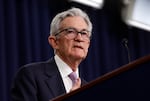
Federal Reserve chairman Jerome Powell and his colleagues lowered interest rates Thursday in response to easing inflation.
Anna Moneymaker
The Federal Reserve lowered interest rates by a quarter percentage point Thursday, as expected — but the central bank may grow more cautious about future rate cuts as it monitors the impact of economic policies in a second Trump administration.
The Fed’s rate-setting committee lowered its benchmark interest rate to a range between 4.5% and 4.75%, as policymakers respond to easing inflation and signs of a slowdown in the job market.
The move follows an aggressive, half-point rate cut at the Fed’s last meeting in September.
Inflation has been inching closer to the Fed’s target of 2%. It was just above that level in September, according to the Commerce Department’s yardstick, which is closely watched by the Fed.
At the same time, hiring has cooled. U.S. employers added just 12,000 jobs in October — although that figure was likely depressed by the Boeing strike, which ended this week, and the fallout of back-to-back hurricanes in the southeast.
The Fed’s job may have gotten tougher
The Fed is trying to strike a balance between interest rates that are high enough to keep inflation in check but not so high as to weaken the job market.
Inflation spiked in the wake of the pandemic and Russia’s invasion of Ukraine. The Fed responded by pushing interest rates to their highest level in more than two decades, and keeping them at that level for over a year before beginning to dial them back this fall.
On average, Fed policymakers projected in September that interest rates would end this year about a quarter percentage point lower than they are now, and would drop by another full point next year.
That rate-cutting roadmap — drafted before this week’s election — could encounter some speed bumps if the president-elect delivers on his economic promises.
Loading...
Trump has pledged to cut taxes, impose sweeping tariffs and deport large numbers of immigrants living in the country illegally.
Analysts say each of those moves could put upward pressure on prices — even though Trump campaigned on a promise to lower inflation — a key concern for many voters. Stubborn inflation could make the Fed more cautious about cutting interest rates in the future.
While the Fed sets short-term interest rates, longer-term borrowing costs are typically set by the bond market. Investors pushed bond yields higher this week, as they braced for the possibility that Trump’s policies could add trillions of dollars in new federal debt.
The rising bond yields pushed mortgage costs up. The average interest rate on a 30-year home loan jumped to 6.79%, according to Freddie Mac.
What will Trump do about the Fed?
Trump also poses a challenge to the Fed’s independence. By design, the central bank is supposed to be insulated from political pressure, so it can make unpopular decisions to raise interest rates if necessary to bring inflation under control.
During his first term in the White House, Trump repeatedly flouted that convention, criticizing the Fed and the chairman he’d appointed for not cutting interest rates fast enough. Trump also slammed the Fed in September for cutting rates shortly before the election, which he worried might help his political rival, Vice President Kamala Harris.
Fed Chair Jerome Powell insists he and his colleagues are guided only by economics in their decision-making and he generally ignored Trump’s jawboning. Powell’s term expires in 2026, however, which could give Trump an opportunity to appoint a more malleable successor.